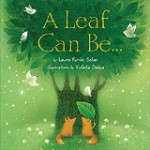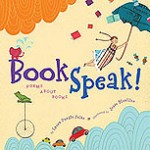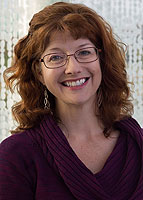In this series, expert school visit presenters share what they’ve learned from experiences in the trenches. Thanks to Laura Purdie Salas for the following contribution.
 1. The school owns you for the day. Do all your negotiating ahead of time. Make sure the schedule is do-able, that you have your necessary bathroom breaks, etc. Then, once you show up, just go with it. If the school asks whether you want to eat lunch on your own or with teachers, offer to eat with teachers (or students)—whatever they will get the most out of. If the numbers/venue aren’t quite as described, oh well. They have brought you there, and all you can do is give them everything you’ve got for the day(s). The kids deserve that.
1. The school owns you for the day. Do all your negotiating ahead of time. Make sure the schedule is do-able, that you have your necessary bathroom breaks, etc. Then, once you show up, just go with it. If the school asks whether you want to eat lunch on your own or with teachers, offer to eat with teachers (or students)—whatever they will get the most out of. If the numbers/venue aren’t quite as described, oh well. They have brought you there, and all you can do is give them everything you’ve got for the day(s). The kids deserve that.
2. Keep your sense of humor. Things will go wrong. Wildly wrong. I’ve had principals change the schedule, fire drills send me into the ladies’ room with a bunch of 4th-grade girls, slides that all appeared green because of a cable mishap, a first grader throw up, a blizzard close down a school, and much more. I learned a great lesson at a Rob Thomas concert when his tech stuff failed. He just laughed, talked with the audience, and tried to give us his best, even in less-than-best circumstances. Laughing beats crying. Save that for the car ride home.
3. If a third party arranges the visit, make sure you get a contact name, email address and phone number for someone actually at the school. And touch base before your visit. I recently appeared for a visit several hours from home, arranged by the local library through a state grant. The school had no idea I was coming. Let me repeat that. No. Idea. If I had contacted the school directly, even though the library wanted to handle all the details, this could have been avoided. (The principal was flexible, the kids and teachers were surprised, and the day went surprisingly well!)
 4. Send posters and free books once the contract is signed. I had some mini-posters printed with a bunch of my book covers and an announcement that “Laura Purdie Salas is coming to school on ________!” On the back of the posters are tips to help the adults prepare for my visit. I send 3-4 posters plus 2-3 of my trade hardcover books in advance. The cost to me is well worth the extra excitement the materials generate.
4. Send posters and free books once the contract is signed. I had some mini-posters printed with a bunch of my book covers and an announcement that “Laura Purdie Salas is coming to school on ________!” On the back of the posters are tips to help the adults prepare for my visit. I send 3-4 posters plus 2-3 of my trade hardcover books in advance. The cost to me is well worth the extra excitement the materials generate.
5. Kids want to connect with you. That’s the most important part of your visit. Yes, design your presentation to support teachers, to correlate to standards, to share content. But then, focus on talking and sharing with kids and listening to them. Make eye contact. Be vulnerable. Be real. That’s how you reach those kids and give them a visit that they will always remember.
 Laura Purdie Salas is the author of more than 100 books for kids and teens, including BOOKSPEAK! POEMS ABOUT BOOKS, STAMPEDE! POEMS TO CELEBRATE THE WILD SIDE OF SCHOOL, and A LEAF CAN BE…. She loves to introduce kids to poetry and help them find poems they can relate to, no matter what their age, mood, and personality. She has also written numerous nonfiction books. See more about Laura and her work at www.laurasalas.com.
Laura Purdie Salas is the author of more than 100 books for kids and teens, including BOOKSPEAK! POEMS ABOUT BOOKS, STAMPEDE! POEMS TO CELEBRATE THE WILD SIDE OF SCHOOL, and A LEAF CAN BE…. She loves to introduce kids to poetry and help them find poems they can relate to, no matter what their age, mood, and personality. She has also written numerous nonfiction books. See more about Laura and her work at www.laurasalas.com.

I found this site, and thus your post, from a Google search. I can fully appreciate your comment about tech breakdowns. The best thing I take away from your post is your poster idea. My questions is this: Do you focus your visits more on the reading process, or the writing process and do you have handouts for the students which support your topic?
I’ve done one successful visit with the fourth graders at my granddaughter’s school upon the launch of my first book, a mid-grade horse story. My second visit, also by invite, is coming up.
Thank you for your great article.